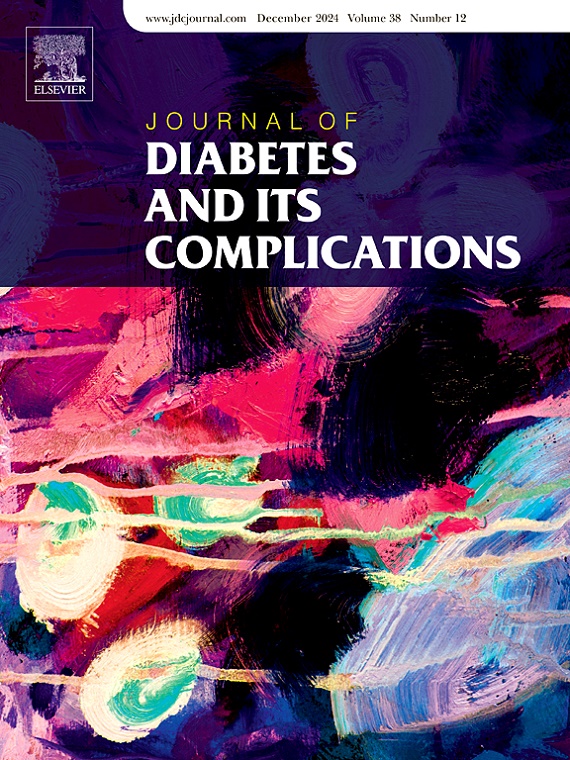The interplay between psychological well-being, diabetes-related distress, and glycemic control: A continuous glucose monitoring analysis from a population of adolescents with type 1 diabetes
IF 3.1
3区 医学
Q3 ENDOCRINOLOGY & METABOLISM
引用次数: 0
Abstract
Aims
This study aims to explore the relationships between glucose control, psychological well-being, and diabetes-related distress in a population of adolescents with T1D.
Methods
We conducted a cross-sectional study on adolescents with T1D attending a Pediatric Diabetes Unit. Demographic, clinical, and glycemic data were collected, including continuous glucose monitoring (CGM) metrics. Psychological well-being was assessed using the PERMA-Profiler, while diabetes-related distress was measured using the Problem Areas in Diabetes-Teen Version (PAID-T) questionnaire.
Results
Among 133 enrolled adolescents, those with HbA1c ≤ 7 % exhibited significantly higher well-being scores (p = 0.007) and lower distress scores (p = 0.035). Higher time in range was positively associated with well-being (p = 0.002), while glycemic variability negatively impacted psychological outcomes (p = 0.023). Female sex (p = 0.021), longer disease duration (p = 0.022), and the absence of insulin pump therapy (p = 0.032) were significantly associated to higher diabetes-related distress.
Conclusions
Glycemic control is closely related to psychological well-being of adolescents living with T1D. The adoption of diabetes technologies may play a crucial role in reducing diabetes-related distress. Future longitudinal studies should investigate the impact of psychological interventions on CGM outcomes and overall quality of life in adolescents with T1D.
心理健康、糖尿病相关痛苦和血糖控制之间的相互作用:一项来自1型糖尿病青少年人群的连续血糖监测分析
目的本研究旨在探讨青少年T1D患者的血糖控制、心理健康和糖尿病相关困扰之间的关系。方法:我们对在儿科糖尿病病房就诊的青少年T1D患者进行了横断面研究。收集了人口统计学、临床和血糖数据,包括连续血糖监测(CGM)指标。心理健康使用PERMA-Profiler进行评估,而与糖尿病相关的痛苦使用糖尿病青少年版问题领域(PAID-T)问卷进行测量。结果在133名入组青少年中,HbA1c≤7%的青少年表现出较高的幸福感得分(p = 0.007)和较低的痛苦得分(p = 0.035)。在范围内停留的时间越长,幸福感越高(p = 0.002),而血糖变异性对心理结果有负面影响(p = 0.023)。女性(p = 0.021)、病程较长(p = 0.022)和缺乏胰岛素泵治疗(p = 0.032)与较高的糖尿病相关焦虑显著相关。结论青少年糖尿病患者血糖控制与心理健康密切相关。糖尿病技术的采用可能在减少糖尿病相关痛苦方面发挥关键作用。未来的纵向研究应该调查心理干预对青少年T1D患者CGM结局和整体生活质量的影响。
本文章由计算机程序翻译,如有差异,请以英文原文为准。
求助全文
约1分钟内获得全文
求助全文
来源期刊

Journal of diabetes and its complications
医学-内分泌学与代谢
CiteScore
5.90
自引率
3.30%
发文量
153
审稿时长
16 days
期刊介绍:
Journal of Diabetes and Its Complications (JDC) is a journal for health care practitioners and researchers, that publishes original research about the pathogenesis, diagnosis and management of diabetes mellitus and its complications. JDC also publishes articles on physiological and molecular aspects of glucose homeostasis.
The primary purpose of JDC is to act as a source of information usable by diabetes practitioners and researchers to increase their knowledge about mechanisms of diabetes and complications development, and promote better management of people with diabetes who are at risk for those complications.
Manuscripts submitted to JDC can report any aspect of basic, translational or clinical research as well as epidemiology. Topics can range broadly from early prediabetes to late-stage complicated diabetes. Topics relevant to basic/translational reports include pancreatic islet dysfunction and insulin resistance, altered adipose tissue function in diabetes, altered neuronal control of glucose homeostasis and mechanisms of drug action. Topics relevant to diabetic complications include diabetic retinopathy, neuropathy and nephropathy; peripheral vascular disease and coronary heart disease; gastrointestinal disorders, renal failure and impotence; and hypertension and hyperlipidemia.
 求助内容:
求助内容: 应助结果提醒方式:
应助结果提醒方式:


